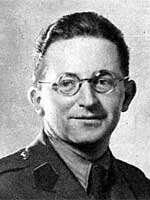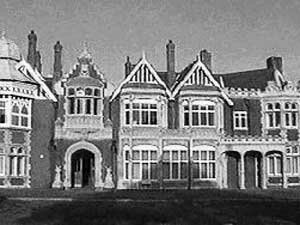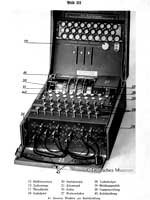The battle
Enigma
 Marian Rejewski
Marian Rejewski
In 1918, the German Arthur Scherbius, wishing to protect the communications of industries and governement, developed a revolutionary method of encoding the communications, which exceeded by far the methods then used.
Called Enigma, the technique of Scherbius offered a hundred and fifty-nine billion of billion possible combinations. His machine, which appearance was similar to a large typewriter, transformed by a set of internal rotors the typed words in series of indecipherable figures. Put into service by the German army in 1926, Enigma protected German communications with an effectiveness such as the secret services from France, Britain, and USA had to give up their attempts to break the code.
 Bletchley Park
Bletchley Park
Finaly, it was Jerzy Rozycki, Henryk Zygalski and Marian Rejewski, young Polish mathematicians of “Biuro Szyfrow”, cipher office of the Polish army, who first started to bore the secrecies of Enigma with some successes. For that, they used the only default of the machine - the key word systematically sent at the beginning of the messages. As of the years 1930s, the German coded messages were clear to the Poles. Thereafter, Rejewski developped an automatic decoding device called “bomba”, a machine which reviewed the various possible combinations in less than 2 hours.
 Enigma In the summer 1939, in front of the rise of the German threat, the Poles managed to pass their discoveries to Great Britain; for instance, a copy of Enigma was conveyed… in the luggage of Sacha Guitry! While the British began to work on Enigma, they could base on and continue the work of Rejewski. A team was assembled in the manor of Bletchley Park, some of the members having been recruited on the basis of crosswords contests of Daily Telegraph. Helped by notebooks of codes recovered on enemy ships, the members the Ultra - name given to the team of the British cypher bureau - developed new decoding automats, able to replace “bomba” from now on obsolete, and to decipher Enigma in less than one hour!
Enigma In the summer 1939, in front of the rise of the German threat, the Poles managed to pass their discoveries to Great Britain; for instance, a copy of Enigma was conveyed… in the luggage of Sacha Guitry! While the British began to work on Enigma, they could base on and continue the work of Rejewski. A team was assembled in the manor of Bletchley Park, some of the members having been recruited on the basis of crosswords contests of Daily Telegraph. Helped by notebooks of codes recovered on enemy ships, the members the Ultra - name given to the team of the British cypher bureau - developed new decoding automats, able to replace “bomba” from now on obsolete, and to decipher Enigma in less than one hour!













 www.evl.pl
www.evl.pl